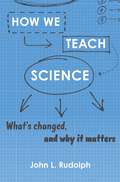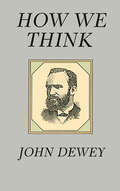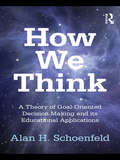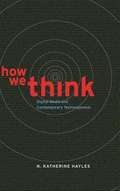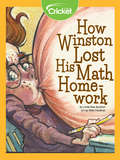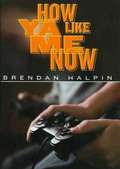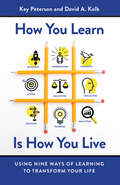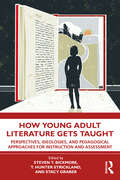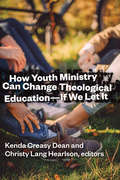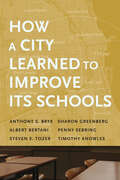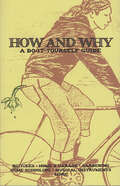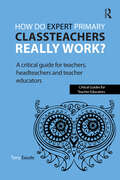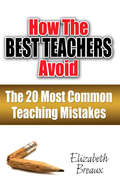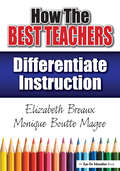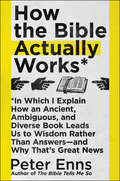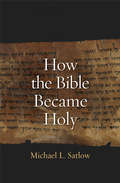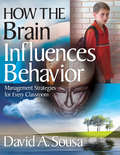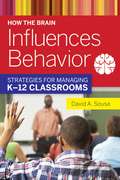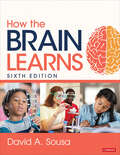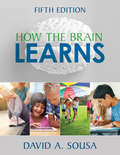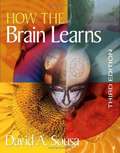- Table View
- List View
How We Teach Science: What’s Changed, and Why It Matters
by John L. RudolphDespite an enduring belief that science should be taught, there has been no enduring consensus about how or why. This is especially true when it comes to teaching scientific process. John Rudolph shows that how we think about and teach science will either sustain or thwart future innovation, and determine how science is perceived by the public.
How We Think
by John DeweyOne of America’s foremost philosophers, John Dewey (1859-1952) fought for civil and academic freedom, founded the Progressive School movement, and steadfastly promoted a scientific approach to intellectual development.In How We Think, Dewey shares his views on the educator’s role in training students to think well. Basing his assertions on the belief that knowledge is strictly relative to human interaction with the world, he considers the need for thought training, its use of natural resources, and its place in school conditions; inductive and deductive reasoning, interpreting facts, and concrete and abstract thinking; the functions of activity, language, and observation in thought training; and many other subjects.John Dewey’s influence on American education and philosophy is incalculable. This volume, as fresh and inspirational today as it was upon its initial publication a century ago, is essential for anyone active in the field of teaching or about to embark on a career in education.
How We Think: A Theory of Goal-Oriented Decision Making and its Educational Applications (Studies in Mathematical Thinking and Learning Series)
by Alan H. SchoenfeldTeachers try to help their students learn. But why do they make the particular teaching choices they do? What resources do they draw upon? What accounts for the success or failure of their efforts? In How We Think, esteemed scholar and mathematician, Alan H. Schoenfeld, proposes a groundbreaking theory and model for how we think and act in the classroom and beyond. Based on thirty years of research on problem solving and teaching, Schoenfeld provides compelling evidence for a concrete approach that describes how teachers, and individuals more generally, navigate their way through in-the-moment decision-making in well-practiced domains. Applying his theoretical model to detailed representations and analyses of teachers at work as well as of professionals outside education, Schoenfeld argues that understanding and recognizing the goal-oriented patterns of our day to day decisions can help identify what makes effective or ineffective behavior in the classroom and beyond.
How We Think: Digital Media and Contemporary Technogenesis
by N. Katherine Hayles"How do we think?" N. Katherine Hayles poses this question at the beginning of this bracing exploration of the idea that we think through, with, and alongside media. As the age of print passes and new technologies appear every day, this proposition has become far more complicated, particularly for the traditionally print-based disciplines in the humanities and qualitative social sciences. With a rift growing between digital scholarship and its print-based counterpart, Hayles argues for contemporary technogenesis--the belief that humans and technics are coevolving--and advocates for what she calls comparative media studies, a new approach to locating digital work within print traditions and vice versa. Hayles examines the evolution of the field from the traditional humanities and how the digital humanities are changing academic scholarship, research, teaching, and publication. She goes on to depict the neurological consequences of working in digital media, where skimming and scanning, or "hyper reading," and analysis through machine algorithms are forms of reading as valid as close reading once was. Hayles contends that we must recognize all three types of reading and understand the limitations and possibilities of each. In addition to illustrating what a comparative media perspective entails, Hayles explores the technogenesis spiral in its full complexity. She considers the effects of early databases such as telegraph code books and confronts our changing perceptions of time and space in the digital age, illustrating this through three innovative digital productions--Steve Tomasula's electronic novel, TOC; Steven Hall's The Raw Shark Texts; and Mark Z. Danielewski's Only Revolutions. Deepening our understanding of the extraordinary transformative powers digital technologies have placed in the hands of humanists, How We Think presents a cogent rationale for tackling the challenges facing the humanities today.
How Winston Lost His Math Homework
by Matt Faulkner Linda Rae ApolzonWinston is in trouble. He didn’t bring his math homework to school, and his teacher isn’t happy! It wasn’t his fault, though. He’d been chewing bubblegum and blowing bubbles, and one of his bubbles goes on an adventure—and takes his homework with it!
How Ya Like Me Now
by Brendan HalpinAfter his father dies and his mother goes into rehab, Eddie moves from the suburbs into his cousin's Boston loft, where he gradually adjusts to being one of the few white kids in a progressive school, and learns how to feel like a normal teenager.
How You Learn Is How You Live: Using Nine Ways of Learning to Transform Your Life
by David A. Kolb Kay PetersonWhat's Your Learning Style?Being a lifelong learner is one of the secrets to happiness, success, and personal fulfillment. But what's the best way to become one? Kay Peterson and David Kolb have the answer. They offer deep, research-based insights into the ideal process of learning and guide you in identifying your dominant style. You'll discover how knowing your learning style can help you with all kinds of everyday challenges, from remembering someone's name to adding a crucial professional skill to your repertoire. This book is a guide to awakening the power of learning that lies within each of us.
How Young Adult Literature Gets Taught: Perspectives, Ideologies, and Pedagogical Approaches for Instruction and Assessment
by Steven T. Bickmore T. Hunter Strickland Stacy GraberA manual for teaching Young Adult Literature, this textbook presents perspectives and methods on how to organize and teach literature in engaging and inclusive ways that meet specific educational and programmatic goals. Each chapter is written by an expert and offers a rich and nuanced approach to teaching YA Literature through a distinct lens. The effective and creative ways to construct a course explored in this book include multimodal, historical, social justice, place-based approaches, and more. The broad spectrum of topics covered in the text gives pre-service teachers and students a toolbox to select and apply methods of their choosing that support effective reading and writing instruction in their own contexts, motivate students, and foster meaningful conversations in the classroom. Chapters feature consistent sections for theory and practice, course structure, suggestions for activities and assessments, and takeaways for further discussion to facilitate easy implementation in the classroom. This book is an essential text for pre-service teachers of English as well as professors and scholars of Young Adult Literature.
How Your Child Is Smart: A Life-Changing Approach to Learning
by Dawna Markova Anne R. PowellThe groundbreaking guide for parents and teachers to identify and understand the different ways children learn.Not all children learn in the same way. So why should they all be taught the same way? Some are verbal gymnasts while others are wandering wonderers; some need to be shown while others need to move. The first step to reaching and teaching each child is to understand his or her innate learning style.Written by two educators, How Your Child is Smart identifies six distinct patterns of learning and teaches parents how to help their children learn and communicate most effectively. Through simple questions, activities, and charts, parents can identify their child's pattern and learn how he or she can best be taught in school.
How Youth Ministry Can Change Theological Education -- If We Let It
by Kenda Creasy Dean Christy Lang HearlsonSince 1993, forty-nine theological seminaries have created opportunities for high school students to participate in on-campus High School Theology Programs (HSTPs) that invite them to engage in serious biblical and theological study. Many of the young people who take part in these programs go on to become pastoral or lay leaders in their churches. What has made these programs so successful — especially given the well-documented “crisis of faith” among young people today? In this book thirteen contributors — many of whom have created or led one of these innovative theology programs — investigate answers to this question. They examine the pedagogical practices the HSTPs have in common and explore how they are contributing to the leadership of the church. They then show how the lessons gleaned from these successful programs can help churches, denominations, and seminaries reimagine both theological education and youth ministry.
How Youth Ministry Can Change Theological Education -- If We Let It
by Kenda Creasy DeanSince 1993, forty-nine theological seminaries have created opportunities for high school students to participate in on-campus High School Theology Programs (HSTPs) that invite them to engage in serious biblical and theological study. Many of the young people who take part in these programs go on to become pastoral or lay leaders in their churches. What has made these programs so successful — especially given the well-documented &“crisis of faith&” among young people today? In this book thirteen contributors — many of whom have created or led one of these innovative theology programs — investigate answers to this question. They examine the pedagogical practices the HSTPs have in common and explore how they are contributing to the leadership of the church. They then show how the lessons gleaned from these successful programs can help churches, denominations, and seminaries reimagine both theological education and youth ministry.
How a City Learned to Improve Its Schools (Continuous Improvement in Education Series)
by Anthony S. Bryk Steven E. Tozer Sharon Greenberg Albert Bertani Penny Sebring Timothy KnowlesA comprehensive analysis of the astonishing changes that elevated the Chicago public school system from one of the worst in the nation to one of the most improved. How a City Learned to Improve Its Schools tells the story of the extraordinary thirty-year school reform effort that changed the landscape of public education in Chicago. Acclaimed educational researcher Anthony S. Bryk joins five coauthors directly involved in Chicago&’s education reform efforts, Sharon Greenberg, Albert Bertani, Penny Sebring, Steven E. Tozer, and Timothy Knowles, to illuminate the many factors that led to this transformation of the Chicago Public Schools. Beginning in 1987, Bryk and colleagues lay out the civic context for reform, outlining the systemic challenges such as segregation, institutional racism, and income and resource disparities that reformers grappled with as well as the social conflicts they faced. Next, they describe how fundamental changes occurred at every level of schooling: enhancing classroom instruction; organizing more engaged and effective local school communities; strengthening the preparation, recruitment, and support of teachers and school leaders; and sustaining an ambitious evidence-based campaign to keep the public informed on the progress of key reform initiatives and the challenges still ahead. The power of this capacity building is validated by unprecedented increases in benchmarks such as graduation rates and college matriculation. This riveting account introduces key actors within the schools, city government, and business community, and the partnerships they forged. It also reveals the surprising yet essential role of Chicago's innovative information infrastructure in aligning disparate initiatives. In making clear how elements such as advocacy, civic capacity, improvement research, and strong democracy contributed to large-scale progress in the system's 600-plus schools, the book highlights the greater lessons that the Chicago story offers for system improvement overall.
How and Why: A Do-It-Yourself Guide (Diy Ser.)
by Matte Resist"I dream of a better world," writes zinester andHow and Why author Matte Resist in the intro to his new book. He continues, "To me DIY culture is about grabbing a little piece of that dream." What follows over the course of the next 176 pages is Matte doing what all dreamers must do-waking up from his dream, opening his eyes, and confronting what roadblocks and hurdles lie between him and his goal. Matte does this by laying down chapter upon chapter of blueprints for a better world. A sequel to our do-it-yourself handbook Making Stuff and Doing Things, How and Why gives us detailed, engaging, easy-to-use info on bicycles, home and garage, gardening, educating children, musical instruments, and the all-inclusive "everything else" section. If you dream of taking back your life and building a better world, How and Why might be your new best friend.
How do expert primary classteachers really work?: A critical guide for teachers, headteachers and teacher educators (Critical Guides for Teacher Educators)
by Tony EaudeThis is an essential text for anyone interested in teaching primary school children, including teacher educators, classteachers and headteachers. What constitutes outstanding or good teaching of children in the primary years is rarely discussed other than in terms of measurable outcomes in literacy and numeracy. This book presents a different view of the distinctive learning needs of 5-11 year-olds and examines the knowledge, skills and attributes required to meet these, especially as a classteacher. Informed by research, but linking this with practical examples, it examines how teachers with a high level of expertise with young children actually think, act and interact. While highlighting the features of such expertise, the challenges of developing it are not overlooked, and the text provides practical pointers on how to do this in both initial teacher education and continuing professional development.This title is part of the successful Critical Guides for Teacher Educators series edited by Ian Menter.
How the Best Teachers Avoid the 20 Most Common Teaching Mistakes
by Elizabeth BreauxFor new teachers and veterans, mentors, instructional coaches, and staff developers, this book shows you how the best teachers avoid and correct the 20 most common teaching mistakes. Clear, direct, and passionate, this book provides tools to help you take charge of your classroom, yourself, your students' educations, and to become the best teacher you can possibly be!
How the Best Teachers Differentiate Instruction
by Monique Magee Elizabeth BreauxThis accessible and practical guide shows teachers how to provide their students with a variety of ways to strengthen their understanding of new material. A selection of assessments is also available to ensure that students have mastered classroom content, regardless of their individual learning styles, abilities, and needs. Contents include: What is differentiated instruction and why do we differentiate? Know your students Management for differentiated instruction 12 ways to differentiate And more!
How the Bible Actually Works: In Which I Explain How An Ancient, Ambiguous, and Diverse Book Leads Us to Wisdom Rather Than Answers -- and Why That's Great News (G - Reference, Information and Interdisciplinary Subjects)
by Peter EnnsControversial evangelical Bible scholar, popular blogger and podcast host of The Bible for Normal People, and author of The Bible Tells Me So and The Sin of Certainty explains that the Bible is not an instruction manual or rule book but a powerful learning tool that nurtures our spiritual growth by refusing to provide us with easy answers but instead forces us to acquire wisdom. For many Christians, the Bible is a how-to manual filled with literal truths about belief that must be strictly followed. But the Bible is not static, Peter Enns argues. It does not hold easy answers to the perplexing questions and issues that confront us in our daily lives. Rather, the Bible is a dynamic instrument for study that not only offers an abundance of insights but provokes us to find our own answers to spiritual questions, cultivating God’s wisdom within us. <P><P>“The Bible becomes a confusing mess when we expect it to function as a rulebook for faith. But when we allow the Bible to determine our expectations, we see that Wisdom, not answers, is the Bible’s true subject matter,” writes Enns. This distinction, he points out, is important because when we come to the Bible expecting it to be a textbook intended by God to give us unwavering certainty about our faith, we are actually creating problems for ourselves. The Bible, in other words, really isn’t the problem; having the wrong expectation is what interferes with our reading.Rather than considering the Bible as an ancient book weighed down with problems, flaws, and contradictions that must be defended by modern readers, Enns offers a vision of the holy scriptures as an inspired and empowering resource to help us better understand how to live as a person of faith today. How the Bible Actually Works makes clear that there is no one right way to read the Bible. Moving us beyond the damaging idea that “being right” is the most important measure of faith, Enns’s freeing approach to Bible study helps us to instead focus on pursuing enlightenment and building our relationship with God—which is exactly what the Bible was designed to do.
How the Bible Became Holy
by Michael L SatlowBeginning with Walt Whitman singing hymns at a wounded soldier's bedside during the Civil War, this surprising and vivid anthology ranges straight through to the twenty-first century to end with Francine Prose crying tears of complicated joy at the sight of Whitman's words in Zuccotti Park during the brief days of the Occupy movement. The first anthology of its kind, Radiant Truths gathers an exquisite selection of writings by both well-known and forgotten American authors and thinkers, each engaged in the challenges of writing about religion, of documenting "things unseen." Their contributions to the genre of literary journalism-the telling of factual stories using the techniques of fiction and poetry-make this volume one of the most exciting anthologies of creative nonfiction to have emerged in years. Jeff Sharlet presents an evocative selection of writings that illuminate the evolution of the American genre of documentary prose. Each entry may be savored separately, but together the works enrich one another, engaging in an implicit and continuing conversation that reaches across time and generations.Including works by: Walt Whitman Henry David Thoreau Mark Twain Meridel Le Sueur Zora Neale Hurston Mary McCarthy James Baldwin Norman Mailer Ellen Willis Anne Fadiman John Jeremiah Sullivan Francine Prose Garry Wills and many others
How the Brain Influences Behavior: Management Strategies for Every Classroom
by Dr David A. SousaCombining theory and practice, this user-friendly guide translates current brain research into practical, effective strategies for controlling or minimizing disruptive behaviors in K–12 classrooms.
How the Brain Influences Behavior: Strategies for Managing K?12 Classrooms
by David A. SousaCombining theory and practice, David A. Sousa helps educators understand what is happening in the brains of students with behavior problems and offers practical, effective intervention strategies compatible with current findings in neuroscience. In easy-to-understand language, the author presents current information on brain development and function and highlights factors that affect social and emotional decision-making and negative behaviors like impulsivity, defiance, and violence. Comprehensive yet concise, this guide for K-12 teachers and counselors provides methods for teaching self-control and fostering positive relationships with troubled students and provides case studies that match effective strategies with specific behaviors. Educators will find answers to critical questions such as: How does the rate of brain development explain erratic behavior of adolescents? What type of data collection can help teachers manage misbehavior? Can peer influence help curb misbehavior rather than encourage it? Why are boys more likely to misbehave than girls and what can teachers do about it? How do school and classroom climates affect student behavior? This invaluable handbook also features reproducible forms, worksheets, checklists, additional references, and an expanded list of primary research sources to help teachers understand and apply research-based principles for classroom and behavior management.
How the Brain Learns
by David A. SousaDeliver game-changing—and brain-changing—results for your students Research on the brain continues to evolve, providing fresh insights educators can use to guide students toward success. In the sixth edition of this international bestseller, world-renowned educational neuroscience consultant David Sousa once again translates that research into concrete actions and strategies for the classroom. Featuring important updates and brand-new findings, the latest edition includes: A new section on the expansion of SEL to SECL, integrating the cognitive component of social-emotional learning Additional research on mindsets—including cautions Effective, brain-compatible ways to safely use social media and online learning New information on the importance of student engagement, especially through academic teams Connections between Bloom’s Taxonomy and current instructional strategies, such as teaming and project/maker learning Whether you’re already a fan of brain-compatible learning or just getting started on this exciting approach to teaching and learning, How the Brain Learns will set your neurons firing—and give you the tools you need to help students succeed.
How the Brain Learns
by David A. SousaDeliver game-changing—and brain-changing—results for your students Research on the brain continues to evolve, providing fresh insights educators can use to guide students toward success. In the sixth edition of this international bestseller, world-renowned educational neuroscience consultant David Sousa once again translates that research into concrete actions and strategies for the classroom. Featuring important updates and brand-new findings, the latest edition includes: A new section on the expansion of SEL to SECL, integrating the cognitive component of social-emotional learning Additional research on mindsets—including cautions Effective, brain-compatible ways to safely use social media and online learning New information on the importance of student engagement, especially through academic teams Connections between Bloom’s Taxonomy and current instructional strategies, such as teaming and project/maker learning Whether you’re already a fan of brain-compatible learning or just getting started on this exciting approach to teaching and learning, How the Brain Learns will set your neurons firing—and give you the tools you need to help students succeed.
How the Brain Learns
by Dr David A. SousaApply the newest brain research to enhance all students’ learning Educational neuroscience consultant David A. Sousa continues his tradition of translating new findings into effective classroom strategies and activities in this updated version of his bestselling text. This fifth edition integrates recent developments in neuroscience, education, and psychology and includes New information on memory systems, especially working memory capacity Updated research on how the explosion of technology is affecting the brain Current findings on brain organization and hemispheric specialization New evidence on how learning the arts enhances cognitive processing and creativity An expanded resources section More than 150 new or updated references
How the Brain Learns
by Dr David A. SousaApply the newest brain research to enhance all students’ learning Educational neuroscience consultant David A. Sousa continues his tradition of translating new findings into effective classroom strategies and activities in this updated version of his bestselling text. This fifth edition integrates recent developments in neuroscience, education, and psychology and includes New information on memory systems, especially working memory capacity Updated research on how the explosion of technology is affecting the brain Current findings on brain organization and hemispheric specialization New evidence on how learning the arts enhances cognitive processing and creativity An expanded resources section More than 150 new or updated references
How the Brain Learns (3rd Edition)
by David A. SousaThe new, Third Edition of How the Brain Learns continues to focus on helping educators turn research on brain functioning into practical classroom strategies. This revised edition includes information on how the brain processes information and how this helps students learn, tips on maximizing student retention using "down time," and such familiar pedagogy from previous editions as the Practitioner's Corner, Key Points to Ponder, and pre- and post-assessments to measure the reader's knowledge. New to the third edition is: Updated information on the Information Processing Model to reflect newer terminology and understandings about memory systems Updated and exciting new research about language acquisition and how the brain learns to read An expanded chapter on thinking skills including the recently revised version of Bloom's Taxonomy More examples of how emotions influence learning and memory New Practitioner's Corners An updated resource section that includes additional books and Internet sites More primary sources for those who wish to review the actual research studies
